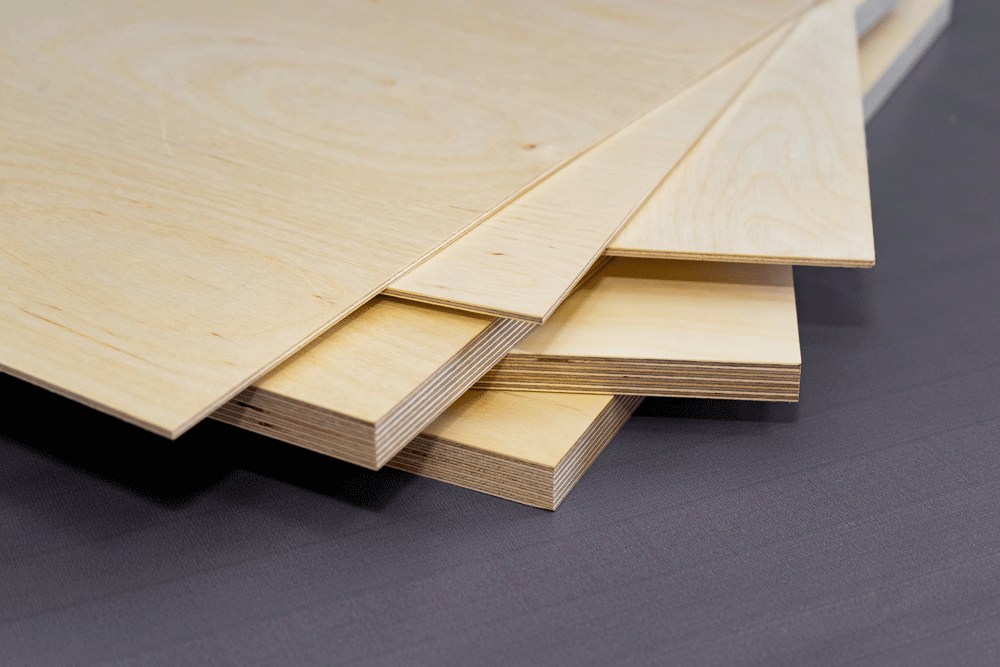Posted: 14th March 2023 | Author: Jamie Brown | Category: Sheet Material
Back to news
Plywood is one of the most well known sheet materials around. There are different types of plywood, including shuttering ply and weather and boil-proof (WBP) plywood, and each type is suited for various uses and projects.
Let’s take a more in depth look at what you should know about plywood.
One of the most important properties of plywood is its strength, which is why it is so good for construction. Plywood can endure high levels of stress without breaking. It also lasts for a long time, reducing the need to replace or repair the material as years go by. On top of this, plywood is also known to be very dimensionally stable compared to other wood materials. This means that it is resistant to the natural warping and shrinkage that can occur over time.
Additionally, plywood can be resistant to water, chemicals and fire, depending on the type you choose. For example, WBP plywood is graded for exterior use when treated with a preservative. This means you can use it outdoors without having to worry about adverse weather conditions taking their toll. It can also be submerged in boiling water without coming apart.
Finally, plywood is a good insulator, both for heat and sound energy. This means that a building cladded with plywood will stay warmer for longer, which reduces heating costs in the long run. The structure of plywood allows it to absorb sound, making it an economical choice for soundproofing.
Due to its strength and durability, plywood is suited to structural applications. It’s often used in the building of partitions, ceilings, sheathings and floors, as well as being used as interior cladding for sound insulation. Externally, plywood may also be used for aesthetic value in exterior cladding and doors. High-specification types of plywood can even be used in marine environments for docks and boats.
Plywood can even be used as a backer board onto which tiles can be laid. Generally, this should involve plywood of an exterior grade and a thickness of at least 18mm, though you may need to use a thicker plywood if heavy loads are expected. You’ll need to make sure that the plywood is stable, level and well-supported underneath. Underfloor ventilation is key to prevent damp becoming a problem as well.
In addition to these larger projects, plywood can also be used in the construction of various items of furniture such as cabinets, shelves, tables and more. It’s cost-effective, durable and easy to use, which makes it a favourite of DIYers for any number of projects, from rabbit hutches and skateboard ramps to workbenches and bookcases. When it comes to constructing items out of plywood, almost anything is possible.
The various grades of plywood mean it can be used in many different ways. In some cases where the decorative quality of the finished project is valued, a higher grade of plywood is used for all parts of the piece that will be easily visible. Then the parts at the back end, that are either contained within other structures or just aren’t likely to be seen, can be constructed using a lower grade of plywood to maintain the highest cost-effectiveness for the job. This is purely done for aesthetic reasons, as the plywood chosen should always have the required practical qualities for the job at hand.
Plywood is so called because it is made up of several layers or plys of wood veneer glued together to form a panel. In some plywoods, these are softwood veneers; in others, the veneers are hardwood. The exact properties of the plywood you choose will in part depend on the type of wood used to make it.
We’ve mentioned that plywood is known to be very durable and dimensionally stable, and the manufacturing process is the reason why. When each new layer of veneer is glued onto the panel, it is laid perpendicular to the previous one. So, if the previous ply had a grain running from top to bottom, the next one would have its grain running side to side. With at least three layers constructed in this fashion, the plywood as a whole is strengthened - because wood tends to shrink or split in the direction of the grain, not against it.
As it is a form of wood, plywood can be a sustainable resource provided the timber used to make it comes from responsibly managed forests. The glue that is used to attach the veneers to each other is a formaldehyde adhesive, which can have a harmful effect on wildlife if consumed, so any spills into rivers or streams can have a big impact. However, the use of formaldehyde is usually regulated in most countries to reduce the risk of this.
The manufacturing process that results in plywood consumes very little energy. Plus, once made, the plywood can last for years and can be recycled if no longer needed. Therefore, plywood is considered to be a highly sustainable material that has a variety of applications within the construction industry.
Back to news
The Author: Jamie Brown
From my early working life as a labourer, then becoming a builder and a property developer, I have been buying and using building materials for over 25 years. I set about to start a builders merchant which can offer high-quality products and significant savings along with speedy delivery to keep your sites moving. Still having a foot in the construction industry on my own property, I always make sure the products we sell are up to our high standards which is important for us to keep a great image for the company and superior reputation to supply quality!